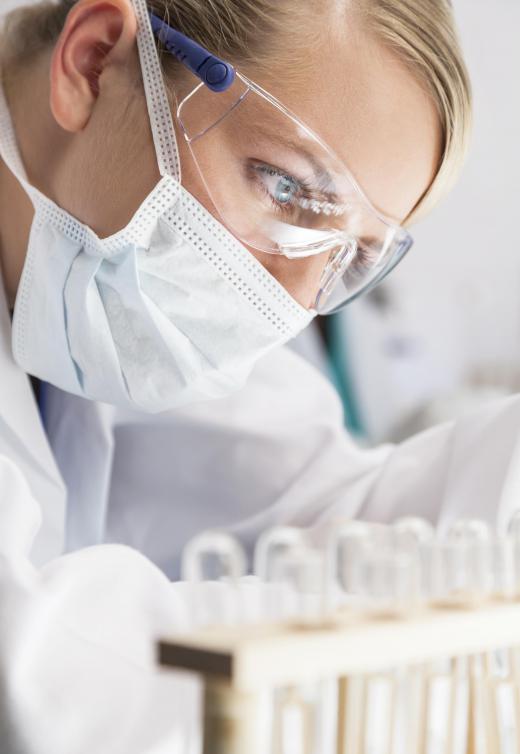What Is an Isoenzyme?
Isoenzymes are enzymes that catalyze identical chemical reactions but are composed of different amino acid sequences. They are sometimes referred to as isozymes. Isoenzymes are produced by different genes and are not redundant despite their similar functions. They occur in many tissues throughout the body and are important for different developmental and metabolic processes.
As an organism evolves, gene duplication occasionally occurs. This might be the result of homologous recombination or gene repair. When natural selection favors the duplicate genetic material, as in cases where the same gene is useful for different processes, the duplicate coding is retained, and isoenzymes are formed.
Isoenzymes are useful biochemical markers and can be measured in the bloodstream to diagnose medical conditions. Alkaline phosphatase (ALP) and lactate dehydrogenase (LDH) are examples of isoenzymes that are commonly used for this purpose.

LDH is essential for anaerobic respiration. When oxygen levels are low, LDH converts pyruvate to lactate, providing a source of muscular energy. This enzyme exists in five isoenzyme varieties in the human body, numbered LDH-1 through LDH-5, and can be found in various tissues, including the heart, liver and lungs.
Elevated levels of specific LDH isoenzymes can indicate tissue damage. For example, after a heart attack, the serum level of LDH-1 is higher than that of LDH-2 because the damaged heart tissue, which is rich in LDH-1, releases that isoenzyme into the bloodstream. High levels of LDH-5 are found primarily in tumors and can indicate the presence of cancer.

ALP is an enzyme that removes phosphate groups from molecules in the body and is important for correct function of the liver, intestines and placenta. Abnormally high or low levels of ALP can indicate a variety of conditions, including liver disease, bone disease and pregnancy. An ALP isoenzyme is also involved in bone growth, and high levels of this isoenzyme can indicate new bone formation.
Isoenzymes can be differentiated from one another using gel electrophoresis. In gel electrophoresis, isoenzyme fragments are drawn through a thick gel by an electric charge. Each isoenzyme has a distinct charge of its own because of its unique amino acid sequence. This enables gel electrophoresis to separate the fragments into bands for identification.
As molecular markers, isoenzymes are useful in population genetics. Isoenzyme studies are conducted on a population level to analyze genetic variation and gene flow. The presence of isoenzymes can be analyzed in cases of new phenotypes, or physiological variations, within species.
AS FEATURED ON:
AS FEATURED ON:












Discussion Comments
Has anyone ever heard of nonalcoholic fatty liver disease? My cousin was recently diagnosed with it, and the only symptom she had was pain in her upper right abdomen.
The doctor did an ALP isoenzyme test and found her levels to be high. He then did an ultrasound and decided that since she never drank alcohol, it must be this type of liver disease.
I really don't know a whole lot about it. Her doctor told her that it can cause her liver to become inflamed. That sounds serious to me, but he seems to think it's not that much of an issue.
One of my friends discovered she was pregnant because of an ALP isoenzyme test. She had gone in for her yearly checkup, and since liver disease ran in her family, she got this test yearly to make sure her liver was still working properly.
She worried when the doctor told her that her ALP levels were high. However, her fear quickly turned to joy when the doctor continued that statement with, “because you're pregnant.”
Apparently, her liver was functioning fine. This was great news, since her body would have to be healthy to support the growing fetus!
@seag47 – Wow, I would have suffered a heart attack from that, too! It's amazing that she survived.
My dad also had a heart attack because of a traumatic event. He saw my brother have a horrible car accident. He survived, but there was blood everywhere.
My dad fell to the ground outside the car, holding his chest. When we got to the hospital, the doctor drew some blood from his arm to check his isoenzyme levels.
He did have a heart attack. Since the isoenzyme test was able to confirm this, the doctor was able to prescribe him some drugs to help prevent further damage.
At the hospital, he got nitroglycerin, which opened up his arteries and helped his blood get through with ease. The doctor told him to start taking an aspirin a day to prevent another heart attack.
My friend's doctor could tell she had suffered a mild heart attack by looking at her isoenzyme levels. Even though it had been weeks since the actual event, he was able to detect the damage.
She had a lot of LDH-1 in her blood. He saw this and gave her some medicine to treat her heart.
Her husband had died a few weeks earlier, and both she and the doctor think that her heart attack happened at that time. She watched him suffer a stroke and heart attack at once, and he died in their bedroom. This is probably when she had her own heart attack.
Post your comments